Paraphrasing skills
- 格式:ppt
- 大小:142.50 KB
- 文档页数:22
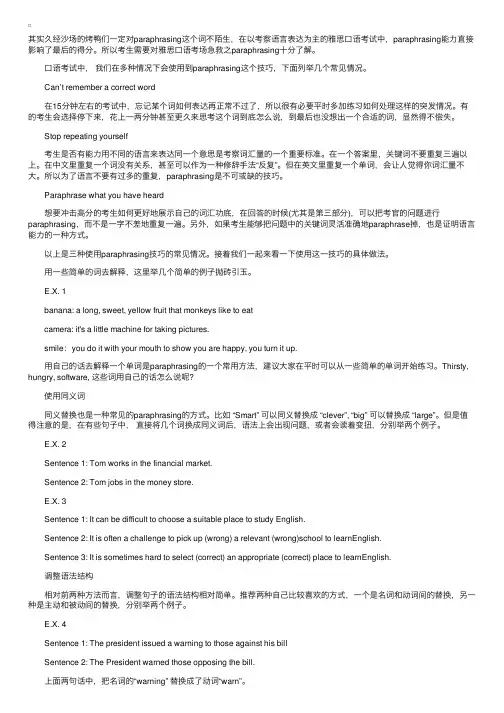
其实久经沙场的烤鸭们⼀定对paraphrasing这个词不陌⽣,在以考察语⾔表达为主的雅思⼝语考试中,paraphrasing能⼒直接影响了最后的得分。
所以考⽣需要对雅思⼝语考场急救之paraphrasing⼗分了解。
⼝语考试中,我们在多种情况下会使⽤到paraphrasing这个技巧,下⾯列举⼏个常见情况。
Can’t remember a correct word 在15分钟左右的考试中,忘记某个词如何表达再正常不过了,所以很有必要平时多加练习如何处理这样的突发情况。
有的考⽣会选择停下来,花上⼀两分钟甚⾄更久来思考这个词到底怎么说,到最后也没想出⼀个合适的词,显然得不偿失。
Stop repeating yourself 考⽣是否有能⼒⽤不同的语⾔来表达同⼀个意思是考察词汇量的⼀个重要标准。
在⼀个答案⾥,关键词不要重复三遍以上。
在中⽂⾥重复⼀个词没有关系,甚⾄可以作为⼀种修辞⼿法“反复”。
但在英⽂⾥重复⼀个单词,会让⼈觉得你词汇量不⼤。
所以为了语⾔不要有过多的重复,paraphrasing是不可或缺的技巧。
Paraphrase what you have heard 想要冲击⾼分的考⽣如何更好地展⽰⾃⼰的词汇功底,在回答的时候(尤其是第三部分),可以把考官的问题进⾏paraphrasing,⽽不是⼀字不差地重复⼀遍。
另外,如果考⽣能够把问题中的关键词灵活准确地paraphrase掉,也是证明语⾔能⼒的⼀种⽅式。
以上是三种使⽤paraphrasing技巧的常见情况。
接着我们⼀起来看⼀下使⽤这⼀技巧的具体做法。
⽤⼀些简单的词去解释,这⾥举⼏个简单的例⼦抛砖引⽟。
E.X. 1 banana: a long, sweet, yellow fruit that monkeys like to eat camera: it's a little machine for taking pictures. smile:you do it with your mouth to show you are happy, you turn it up. ⽤⾃⼰的话去解释⼀个单词是paraphrasing的⼀个常⽤⽅法,建议⼤家在平时可以从⼀些简单的单词开始练习。

仿写句子的意思是什么什么是仿写句子?仿写句子是指通过改变原始句子的结构、语法和词汇,来创造出新的句子。
从语言角度来看,它不仅可以帮助人们加强语感和语言能力,还可以帮助人们深入理解原始句子所表达的意义和情感。
因此,学习仿写句子在中小学语文教育中也是非常重要的一部分。
仿写的例子:1. 原始句子:昨天的考试要求我们用英语写作文。
仿写句子:昨天的考试,要求我们用英文写作文。
2. 原始句子:他又啃了一口苹果,继续工作。
仿写句子:他啃了一口苹果,然后就继续工作了。
3. 原始句子:他一只手拿着书,一只手拿着笔。
仿写句子:他一边拿着书,一边拿着笔。
为什么要学习仿写句子?1. 帮助人们加强语感和语言能力仿写句子需要学生们在模仿中自己动手构思,这一过程既可以帮助学生建立起语言的框架,也可以提高学生对语言的敏感度,对具体的词组形成语感,进而加深对语言的理解。
2. 帮助人们深入理解原始句子所表达的意义和情感通过仿写句子的过程,人们可以了解到原始句子的结构和语法,进而更深刻地理解原始句子所表达的意义以及作者所传递的情感。
3. 帮助人们提高写作能力模仿是学习的一个很好的方法。
通过仿写句子的训练,学生可以得到很好的写作习惯,能在平时的写作中使用到仿写句子的技巧,这将有助于他们更快速地提高他们的写作能力。
总之,通过学习仿写句子,在对语言的理解和运用、对语言的敏感度、对写作能力的提高等方面都有很好的作用。
参考译文:What is Paraphrasing?Paraphrasing refers to the process of creating new sentences by changing the structure, grammar, and vocabulary of the original sentence. From a linguistic perspective, it not only helps people strengthen their sense of language and language ability but also helps people to deepen their understanding of the meaning and emotions conveyed by the original sentence. Therefore, learning paraphrasing is also a very important part in primary and secondary school language education.Examples of paraphrasing:1.Original sentence: The test yesterday required us to write an essay in English.Paraphrased sentence: The test yesterday required us to write an English essay.2. Original sentence: He took another bite of the apple and continued to work.Paraphrased sentence: He took a bite of the apple, and then continued to work.3. Original sentence: He held a book in one hand and a pen in the other.Paraphrased sentence: He held a book in one hand, and a pen in the other.Why learn paraphrasing?1. Helps people strengthen their sense of language and language abilityParaphrasing requires students to think for themselves through imitation. This process can not only help students establish a language framework but also to improve their sensitivity to language, form a sense of specific phrases, and deepen their understanding of language.2. Helps people deepen their understanding of the meaning andemotions conveyed by the original sentenceThrough the process of paraphrasing, people can understand the structure and grammar of the original sentence and then more deeply understand the meaning and emotions communicated by the author.3. Helps people improve their writing skillsImitation is a good way of learning. Through the training of paraphrasing, students can form good writing habits and apply the paraphrasing skills in their writing. This will help them to quickly improve their writing skills.In summary, by learning paraphrasing, it has a good effect on understanding and applying language, sensitivity to language, and improving writing ability.。
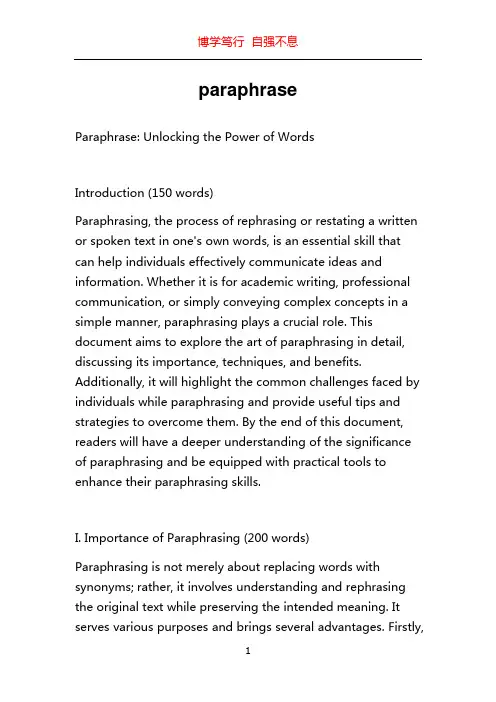
paraphraseParaphrase: Unlocking the Power of WordsIntroduction (150 words)Paraphrasing, the process of rephrasing or restating a written or spoken text in one's own words, is an essential skill that can help individuals effectively communicate ideas and information. Whether it is for academic writing, professional communication, or simply conveying complex concepts in a simple manner, paraphrasing plays a crucial role. This document aims to explore the art of paraphrasing in detail, discussing its importance, techniques, and benefits. Additionally, it will highlight the common challenges faced by individuals while paraphrasing and provide useful tips and strategies to overcome them. By the end of this document, readers will have a deeper understanding of the significance of paraphrasing and be equipped with practical tools to enhance their paraphrasing skills.I. Importance of Paraphrasing (200 words)Paraphrasing is not merely about replacing words with synonyms; rather, it involves understanding and rephrasing the original text while preserving the intended meaning. It serves various purposes and brings several advantages. Firstly,paraphrasing allows individuals to internalize information and express it in their own unique way, enhancing their comprehension of the topic. This is particularly useful in academic settings, where paraphrasing is an essential aspect of avoiding plagiarism. Moreover, paraphrasing can help improve writing skills, as it encourages individuals to think critically and engage with the content, resulting in more coherent and original pieces of writing. Additionally, paraphrasing aids in effective communication, especially in situations where information needs to be simplified or rephrased for different audiences. It allows individuals to adapt their language and style to suit the specific needs of their target audience, making the message more accessible and comprehensible.II. Techniques for Effective Paraphrasing (400 words)While paraphrasing may seem straightforward, implementing effective techniques can greatly enhance the quality of the paraphrased text. The following techniques can be employed to ensure accurate and successful paraphrasing:1. Understand the Source Material: Before attempting to paraphrase a text, it is crucial to read and comprehend the original content thoroughly. This includes understanding the main ideas, arguments, and supporting evidence.2. Use Synonyms and Different Sentence Structures: While it is essential to avoid using the exact same words as the original text, incorporating synonyms and different sentence structures can help convey the same message in a unique manner. However, caution must be exercised to ensure that the paraphrased content remains true to the original meaning.3. Change Word Forms and Sentence Order: Altering the form of words (e.g., changing nouns into verbs, adjectives into adverbs) and rearranging the sentence structure can effectively paraphrase a sentence while maintaining its original meaning.4. Paraphrase Entire Paragraphs: In some instances, it may be more effective to paraphrase an entire paragraph rather than focusing on individual sentences. This approach allows for a more comprehensive understanding and expression of ideas.5. Attribute Ideas to the Original Source: When paraphrasing, it is essential to give credit where it is due by attributing the ideas to the original source. This is particularly critical in academic writing to avoid plagiarism.III. Overcoming Challenges in Paraphrasing (300 words)Paraphrasing can be a challenging task, especially for individuals who are new to the concept. Some common challenges and potential strategies to overcome them include:1. Maintaining Original Meaning: One of the key challenges is ensuring that the paraphrased text retains the original meaning. To overcome this, it is important to thoroughly comprehend the source material and focus on conveying the core ideas rather than replicating the exact words.2. Avoiding Plagiarism: Paraphrasing is often done to avoid plagiarism, but improper paraphrasing can still lead to unintentional plagiarism. To mitigate this risk, it is crucial to consistently attribute ideas to the original source and use proper citation formats.3. Striking a Balance with Quotations: While paraphrasing is crucial, it is equally important to know when to use direct quotations. Direct quotes should be used sparingly to support key arguments or when the wording itself is essential to the discussion.4. Developing Paraphrasing Skills: Paraphrasing is a skill that improves with practice. Regularly engaging in paraphrasingexercises and seeking feedback from peers or instructors can help develop and refine this skill.Conclusion (150 words)In today's information age, where effective communication is paramount, mastering the art of paraphrasing is more crucial than ever. It enables individuals to convey information accurately and concisely, taking into account the diverse needs of different audiences. The techniques discussed in this document, such as understanding the source material, using synonyms and different sentence structures, and properly attributing ideas, can greatly enhance one's paraphrasing abilities. Overcoming the challenges associated with paraphrasing is possible through practice and a sound understanding of the original text's core ideas. By harnessing the power of words through paraphrasing, individuals can elevate their writing, communication, and overall literacy skills, positioning themselves for success in various personal and professional endeavors.。
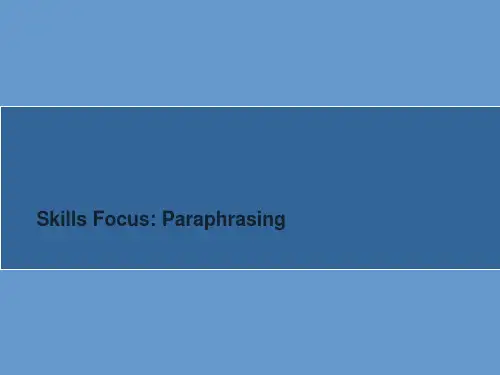
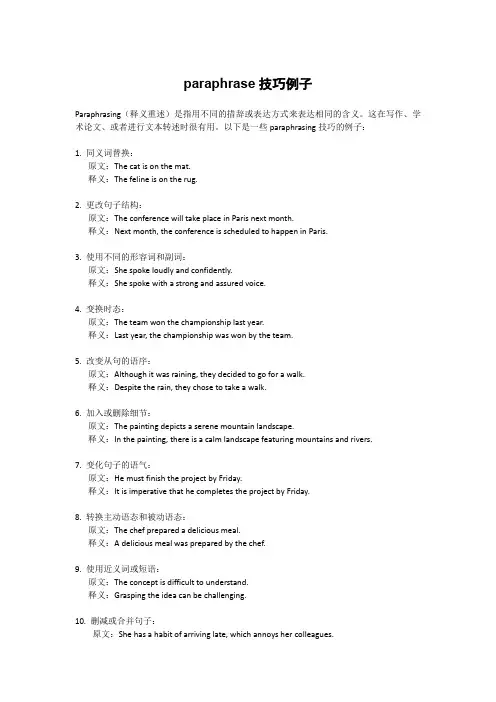
paraphrase技巧例子Paraphrasing(释义重述)是指用不同的措辞或表达方式来表达相同的含义。
这在写作、学术论文、或者进行文本转述时很有用。
以下是一些paraphrasing技巧的例子:1. 同义词替换:原文:The cat is on the mat.释义:The feline is on the rug.2. 更改句子结构:原文:The conference will take place in Paris next month.释义:Next month, the conference is scheduled to happen in Paris.3. 使用不同的形容词和副词:原文:She spoke loudly and confidently.释义:She spoke with a strong and assured voice.4. 变换时态:原文:The team won the championship last year.释义:Last year, the championship was won by the team.5. 改变从句的语序:原文:Although it was raining, they decided to go for a walk.释义:Despite the rain, they chose to take a walk.6. 加入或删除细节:原文:The painting depicts a serene mountain landscape.释义:In the painting, there is a calm landscape featuring mountains and rivers.7. 变化句子的语气:原文:He must finish the project by Friday.释义:It is imperative that he completes the project by Friday.8. 转换主动语态和被动语态:原文:The chef prepared a delicious meal.释义:A delicious meal was prepared by the chef.9. 使用近义词或短语:原文:The concept is difficult to understand.释义:Grasping the idea can be challenging.10. 删减或合并句子:原文:She has a habit of arriving late, which annoys her colleagues.释义:Her habit of arriving late is a source of annoyance for her colleagues.这些例子展示了paraphrasing的不同技巧,通过运用这些技巧,你可以更灵活地表达相同的意思,从而使文本更加多样化和富有表达力。
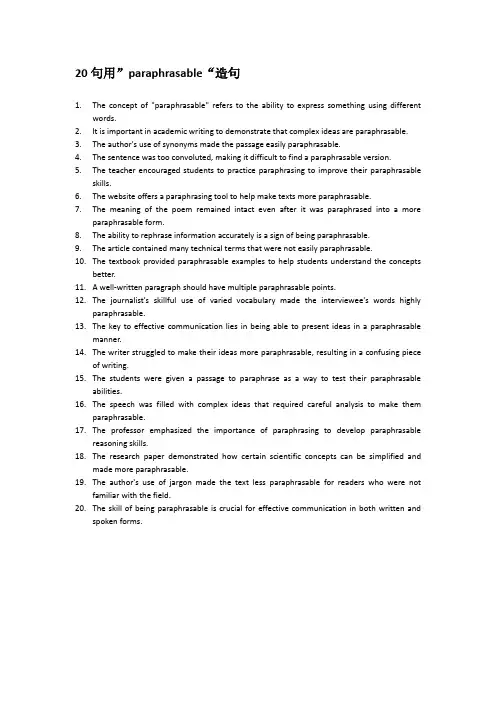
20句用”paraphrasable“造句1.The concept of "paraphrasable" refers to the ability to express something using differentwords.2.It is important in academic writing to demonstrate that complex ideas are paraphrasable.3.The author's use of synonyms made the passage easily paraphrasable.4.The sentence was too convoluted, making it difficult to find a paraphrasable version.5.The teacher encouraged students to practice paraphrasing to improve their paraphrasableskills.6.The website offers a paraphrasing tool to help make texts more paraphrasable.7.The meaning of the poem remained intact even after it was paraphrased into a moreparaphrasable form.8.The ability to rephrase information accurately is a sign of being paraphrasable.9.The article contained many technical terms that were not easily paraphrasable.10.The textbook provided paraphrasable examples to help students understand the conceptsbetter.11. A well-written paragraph should have multiple paraphrasable points.12.The journalist's skillful use of varied vocabulary made the interviewee's words highlyparaphrasable.13.The key to effective communication lies in being able to present ideas in a paraphrasablemanner.14.The writer struggled to make their ideas more paraphrasable, resulting in a confusing pieceof writing.15.The students were given a passage to paraphrase as a way to test their paraphrasableabilities.16.The speech was filled with complex ideas that required careful analysis to make themparaphrasable.17.The professor emphasized the importance of paraphrasing to develop paraphrasablereasoning skills.18.The research paper demonstrated how certain scientific concepts can be simplified andmade more paraphrasable.19.The author's use of jargon made the text less paraphrasable for readers who were notfamiliar with the field.20.The skill of being paraphrasable is crucial for effective communication in both written andspoken forms.。
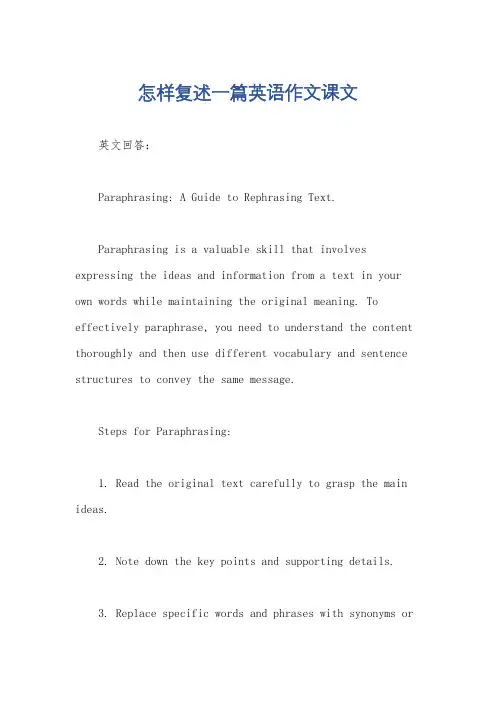
怎样复述一篇英语作文课文英文回答:Paraphrasing: A Guide to Rephrasing Text.Paraphrasing is a valuable skill that involves expressing the ideas and information from a text in your own words while maintaining the original meaning. To effectively paraphrase, you need to understand the content thoroughly and then use different vocabulary and sentence structures to convey the same message.Steps for Paraphrasing:1. Read the original text carefully to grasp the main ideas.2. Note down the key points and supporting details.3. Replace specific words and phrases with synonyms oralternative expressions.4. Alter the sentence structure and word order without changing the meaning.5. Maintain the overall tone and style of the original text.6. Ensure that your paraphrase is concise and clear.Benefits of Paraphrasing:1. Enhances understanding: Paraphrasing forces you to think deeply about the text, aiding in comprehension.2. Improves writing skills: By practicing paraphrasing, you develop your vocabulary and improve your ability to express ideas clearly.3. Prevents plagiarism: Paraphrasing allows you to use someone else's ideas without directly copying them.4. Encourages critical thinking: It challenges your ability to interpret and convey information in alternative ways.Techniques for Paraphrasing:1. Substitute words: Replace specific terms with synonyms or more general words.2. Change sentence structure: Alter the word order or combine multiple sentences into one.3. Add or remove details: Summarize or expand on certain points to enhance clarity.4. Use different grammatical constructions: Convert active voice to passive voice or vice versa.5. Change the perspective: Express the ideas from a different viewpoint.中文回答:如何复述一篇英语作文。
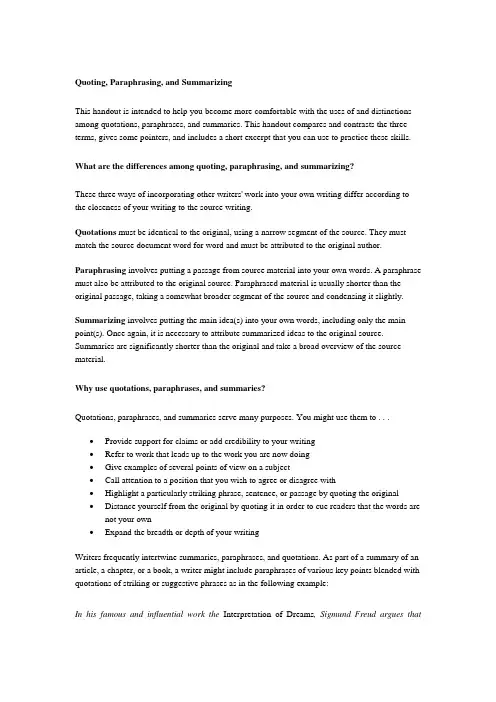
Quoting, Paraphrasing, and SummarizingThis handout is intended to help you become more comfortable with the uses of and distinctions among quotations, paraphrases, and summaries. This handout compares and contrasts the three terms, gives some pointers, and includes a short excerpt that you can use to practice these skills.What are the differences among quoting, paraphrasing, and summarizing?These three ways of incorporating other writers' work into your own writing differ according to the closeness of your writing to the source writing.Quotations must be identical to the original, using a narrow segment of the source. They must match the source document word for word and must be attributed to the original author.Paraphrasing involves putting a passage from source material into your own words. A paraphrase must also be attributed to the original source. Paraphrased material is usually shorter than the original passage, taking a somewhat broader segment of the source and condensing it slightly.Summarizing involves putting the main idea(s) into your own words, including only the main point(s). Once again, it is necessary to attribute summarized ideas to the original source. Summaries are significantly shorter than the original and take a broad overview of the source material.Why use quotations, paraphrases, and summaries?Quotations, paraphrases, and summaries serve many purposes. You might use them to . . .•Provide support for claims or add credibility to your writing•Refer to work that leads up to the work you are now doing•Give examples of several points of view on a subject•Call attention to a position that you wish to agree or disagree with•Highlight a particularly striking phrase, sentence, or passage by quoting the original•Distance yourself from the original by quoting it in order to cue readers that the words are not your own•Expand the breadth or depth of your writingWriters frequently intertwine summaries, paraphrases, and quotations. As part of a summary of an article, a chapter, or a book, a writer might include paraphrases of various key points blended with quotations of striking or suggestive phrases as in the following example:In his famous and influential work the Interpretation of Dreams, Sigmund Freud argues thatdreams are the "royal road to the unconscious" (page #), expressing in coded imagery thedreamer's unfulfilled wishes through a process known as the "dream-work" (page #). According toFreud, actual but unacceptable desires are censored internally and subjected to coding throughlayers of condensation and displacement before emerging in a kind of rebus puzzle in the dreamitself (page #).How to use quotations, paraphrases, and summariesPractice summarizing the essay below, using paraphrases and quotations as you go. It might be helpful to follow these steps:•Read the entire text, noting the key points and main ideas.•Summarize in your own words what the single main idea of the essay is.•Paraphrase important supporting points that come up in the essay.•Consider any words, phrases, or brief passages that you believe should be quoted directly.There are several ways to integrate quotations into your text. Often, a short quotation works well when integrated into a sentence. Longer quotations can stand alone. Remember that quoting should be done only sparingly; be sure that you have a good reason to include a direct quotation when you decide to do so.The following is a sample essay you can practice quoting, paraphrasing, and summarizing. Examples of each task are provided at the end of the essay for further reference.Here is the citation for Sipher's essay:Sipher, Roger. “So That Nobody Has to Go to School If They Don't Want To.” The New York Times. 19 December 1977. Page 31. Print.So That Nobody Has To Go To School If They Don't Want Toby Roger SipherA decline in standardized test scores is but the most recent indicator that American education is in trouble.One reason for the crisis is that present mandatory-attendance laws force many to attend school who have no wish to be there. Such children have little desire to learn and are so antagonistic toschool that neither they nor more highly motivated students receive the quality education that is the birthright of every American.The solution to this problem is simple: Abolish compulsory-attendance laws and allow only those who are committed to getting an education to attend.This will not end public education. Contrary to conventional belief, legislators enacted compulsory-attendance laws to legalize what already existed. William Landes and Lewis Solomon, economists, found little evidence that mandatory-attendance laws increased the number of children in school. They found, too, that school systems have never effectively enforced such laws, usually because of the expense involved.There is no contradiction between the assertion that compulsory attendance has had little effect on the number of children attending school and the argument that repeal would be a positive step toward improving education. Most parents want a high school education for their children. Unfortunately, compulsory attendance hampers the ability of public school officials to enforce legitimate educational and disciplinary policies and thereby make the education a good one.Private schools have no such problem. They can fail or dismiss students, knowing such students can attend public school. Without compulsory attendance, public schools would be freer to oust students whose academic or personal behavior undermines the educational mission of the institution.Has not the noble experiment of a formal education for everyone failed? While we pay homage to the homily, "You can lead a horse to water but you can't make him drink," we have pretended it is not true in education.Ask high school teachers if recalcitrant students learn anything of value. Ask teachers if these students do any homework. Quite the contrary, these students know they will be passed from grade to grade until they are old enough to quit or until, as is more likely, they receive a high school diploma. At the point when students could legally quit, most choose to remain since they know they are likely to be allowed to graduate whether they do acceptable work or not.Abolition of archaic attendance laws would produce enormous dividends.First, it would alert everyone that school is a serious place where one goes to learn. Schools are neither day-care centers nor indoor street corners. Young people who resist learning should stay away; indeed, an end to compulsory schooling would require them to stay away.Second, students opposed to learning would not be able to pollute the educational atmosphere for those who want to learn. Teachers could stop policing recalcitrant students and start educating.Third, grades would show what they are supposed to: how well a student is learning. Parents could again read report cards and know if their children were making progress.Fourth, public esteem for schools would increase. People would stop regarding them as way stations for adolescents and start thinking of them as institutions for educating America's youth.Fifth, elementary schools would change because students would find out early they had better learn something or risk flunking out later. Elementary teachers would no longer have to pass their failures on to junior high and high school.Sixth, the cost of enforcing compulsory education would be eliminated. Despite enforcement efforts, nearly 15 percent of the school-age children in our largest cities are almost permanently absent from school.Communities could use these savings to support institutions to deal with young people not in school. If, in the long run, these institutions prove more costly, at least we would not confuse their mission with that of schools.Schools should be for education. At present, they are only tangentially so. They have attempted to serve an all-encompassing social function, trying to be all things to all people. In the process they have failed miserably at what they were originally formed to accomplish.Example Summary, Paraphrase, and Quotation from the Essay:Example summary: Roger Sipher makes his case for getting rid of compulsory-attendance laws in primary and secondary schools with six arguments. These fall into three groups—first that education is for those who want to learn and by including those that don't want to learn, everyone suffers. Second, that grades would be reflective of effort and elementary school teachers wouldn't feel compelled to pass failing students. Third, that schools would both save money and save face with the elimination of compulsory-attendance laws.Example paraphrase of the essay's conclusion: Roger Sipher concludes his essay by insisting that schools have failed to fulfill their primary duty of education because they try to fill multiple social functions (para. 17).Example quotation: According to Roger Sipher, a solution to the perceived crisis of American education is to "Abolish compulsory-attendance laws and allow only those who are committed to getting an education to attend" (para. 3).。

7招搞定概要写作中的paraphrasing1)。
The teacher asked the students to XXX可以改写成The students XXX.2)。
XXX.可以改写成As a result of his XXX。
XXX.5.第五招:增减法。
即在原句的基础上增加或删除一些信息,使其表达更加精炼。
例:1)。
The company is planning to launch a new product next month.可以改写成The company plans to launch a new product next month.2)。
The book is about the history of the American n。
which happened in the late 18th century.可以改写成The book is about the late 18th century XXX.6.第六招:转换视角法。
即从不同的角度来表达相同的意思。
例:1)。
The government should do more to ce air n.可以改写成More should be done by the government to ce air n.2)。
The company needs to XXX.可以改写成XXX better service from the company.7.第七招:改变语态法。
即改变主动语态为被动语态或被动语态为主动语态。
例:1)。
The teacher gave the students a test.可以改写成A test was given to the students by the teacher.2)。
The car was hit by a truck.可以改写成A truck hit the car.1) Children deserve XXX.2) In order to help children learn faster。
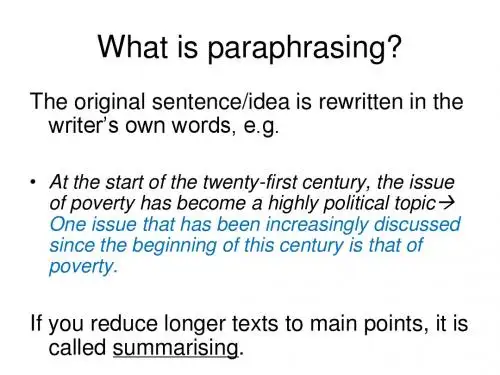
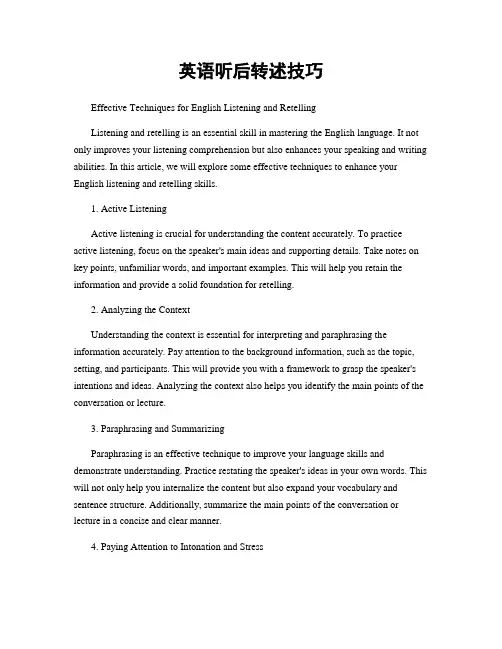
英语听后转述技巧Effective Techniques for English Listening and RetellingListening and retelling is an essential skill in mastering the English language. It not only improves your listening comprehension but also enhances your speaking and writing abilities. In this article, we will explore some effective techniques to enhance your English listening and retelling skills.1. Active ListeningActive listening is crucial for understanding the content accurately. To practice active listening, focus on the speaker's main ideas and supporting details. Take notes on key points, unfamiliar words, and important examples. This will help you retain the information and provide a solid foundation for retelling.2. Analyzing the ContextUnderstanding the context is essential for interpreting and paraphrasing the information accurately. Pay attention to the background information, such as the topic, setting, and participants. This will provide you with a framework to grasp the speaker's intentions and ideas. Analyzing the context also helps you identify the main points of the conversation or lecture.3. Paraphrasing and SummarizingParaphrasing is an effective technique to improve your language skills and demonstrate understanding. Practice restating the speaker's ideas in your own words. This will not only help you internalize the content but also expand your vocabulary and sentence structure. Additionally, summarize the main points of the conversation or lecture in a concise and clear manner.4. Paying Attention to Intonation and StressIntonation and stress play a crucial role in understanding spoken English. Pay attention to the speaker's emphasis, pitch changes, and pauses. This will help you identify the important information and the speaker's attitude or intention. Mimicking the speaker's intonation and stress patterns can also improve your pronunciation and fluency.5. Using Visual CuesVisual cues can provide additional context and support your understanding of spoken English. If available, watch videos or listen to audio recordings with accompanying visuals. This can include gestures, facial expressions, or props. Observing these visual cues will enhance your comprehension and help you retell the information accurately.6. Practice with a Variety of MaterialsExpose yourself to various types of listening materials to improve your skills. This can include podcasts, TED talks, news broadcasts, movies, or documentaries. Choose topics that interest you, as it will motivate you to focus and comprehend the content. Practice listening and retelling regularly to build your confidence and fluency.7. Seek Feedback and GuidanceTo improve your listening and retelling skills, seek feedback from teachers, native speakers, or language exchange partners. They can provide valuable insights and correct any mistakes you make. Participating in language exchange programs or conversation clubs can provide a supportive and interactive environment to practice your skills.8. Use Technology to Your AdvantageTechnology offers numerous resources to enhance your listening and retelling skills. Utilize language learning apps, online courses, or language exchange platforms. These tools provide a wide range of listening materials, exercises, and opportunities for practice. Take advantage of these resources to supplement your learning and track your progress.In conclusion, developing effective listening and retelling skills is vital for mastering the English language. Practice active listening, analyze the context, and improve your paraphrasing and summarizing abilities. Pay attention to intonation and stress, use visualcues, and practice with a variety of materials. Seek feedback and guidance from others, and utilize technology to supplement your learning. With dedication and practice, you will greatly enhance your English listening and retelling skills.。
paraphrase的名词形式Paraphrasing是指通过使用不同的语言表达同一段文字的过程。
当我们需要更简单地表达某段文字时,我们可以利用paraphrasing的技巧来达到这个目的。
当然,在不破坏原意的情况下进行paraphrasing非常重要。
因此,名词形式“paraphrase”也是一个很重要的词汇,因为它在我们的日常口语和写作中都有很大的用途。
那么,我们如何准确地理解paraphrase的名词形式?以下是一些有用的步骤:第一步:理解paraphrase的含义。
如上所述,paraphrasing是指通过使用不同的语言表达同一段文字的过程。
它与复制或抄袭是不同的,因为我们必须在尊重原始文本的同时改变语言表达。
因此,paraphrase的名词形式代表这个过程,它是在复制和抄袭之外的第三种选项。
第二步:查找paraphrase的各种例子。
我们可以在书籍、文章、新闻等不同的文本类型中找到paraphrase的例子。
这些例子可以帮助我们更好地理解paraphrase的名词形式,并确定在何种情况下可以使用它。
更具体地说,当需要表达某种观点但不想使用原有的语言表述时,可以通过paraphrase来达到这个目的。
第三步:练习paraphrasing技巧。
练习paraphrasing技巧可以帮助我们更好地应用它们。
我们可以使用一些工具和技巧,例如换用不同的词汇、改变句子结构、利用同义词和更改动词时态等等。
同时,可以使用一些在线paraphrasing 工具来练习这些技巧。
第四步:应用paraphrasing的名词形式。
一旦我们了解了paraphrasing的含义并练习了一些技巧,就可以在口语和写作中应用它们。
例如,在论文中,我们可以使用paraphrasing的技巧来表达别人的观点和实验结果,而不是只是复制和粘贴原始文本。
在日常对话中,我们可以使用paraphrasing技巧来更好地让别人理解我们的观点。
口译中paraphrasing英文解释全文共6篇示例,供读者参考篇1The Magic of Paraphrasing: Putting Things in Your Own WordsHave you ever played the telephone game? It's when one person whispers a message to another, who then whispers it to the next person, and so on. By the time the message reaches the last person, it's often completely different from the original! That's because each person naturally uses their own words to repeat what they heard.Well, interpreters do something similar, but in a much more careful and skilled way. It's called paraphrasing, and it's like magical word alchemy!What is Paraphrasing?Paraphrasing means taking someone's words or ideas and expressing them in your own words, without changing the original meaning. It's like rewrapping a present in new paper,篇2Paraphrasing: Saying It In Your Own WordsHave you ever had a teacher ask you to paraphrase something you just read? At first, it can seem really confusing and hard to do. But paraphrasing is just taking the main ideas from something and putting them into your own words. It's like translating from one language to another - except you're translating from the author's words into your own!As an interpreter, paraphrasing is a super important skill. When I'm interpreting from English to my native language, I can't just directly translate every single word. That would sound really awkward and robotic. Instead, I have to listen carefully, understand the full meaning, and then rephrase it naturally in my own words. It's almost like being a voice actor!Let me give you an example. Let's say the English speaker says: "Due to the inclement weather conditions, we have decided to postpone the outdoor event until next week." That's a pretty formal way to say it. If I just directly translated it word-for-word into my language, it would sound really stiff and unnatural.But if I paraphrase it in my own words like "Hey guys, since it's going to rain a lot today, we're going to have to reschedule our picnic for next Saturday instead," that flows much morenaturally. I captured all the key information, but in a friendly, conversational way that fits how people actually talk.Paraphrasing lets me take those heavy, complicated English sentences and make them simpler and easier to understand in my language. But it's not just about using simpler words - it's about restructuring the whole message in a way that sounds natural to the listener's ear.It's kind of like being a translator for the movie Inception - I have to go layers deep into understanding the true meaning behind the English, then rebuild it from the ground up in a new form. If I get stuck on little details or trying to literally translate things, I'll end up stumbling over my words or losing the overall point entirely.But paraphrasing is also really fun because it lets me get creative with how I rephrase things. I can sprinkle in my own analogies, examples, and speaking style to make it more relatable and engaging for my audience. Rather than just being a parrot repeating the same dry lines, I get to be a storyteller painting a clearer picture tailored specifically for them.While paraphrasing is definitely challenging, it's one of the most important skills for being an awesome interpreter. It lets me bridge languages in a clear, natural way - making even themost complex English explanations feel like a friendly conversation in my native tongue.Plus, it's an incredible brain exercise! All the active listening, analyzing, and creative rewording gives my thinking muscles one heck of a workout. I'm constantly expanding my vocabulary and communications skills in both languages. Who knows, maybe all this paraphrasing practice will turn me into a legendary orator and author one day!So next time you have to paraphrase something in class, don't sweat it. Just put on your interpreter headset, picture your audience, and have fun translating those ideas into your own words. The more you practice, the easier it'll become to smoothly rephrase anything - English passages, teacher instructions, you name it - in your own authentic voice. Paraphrasing is the key to being a true master communicator!篇3Paraphrasing: Saying It Your Own WayHi friends! Today I want to talk about something called "paraphrasing" that happens a lot when interpreters translate from one language to another. It might sound like a big fancyword, but paraphrasing is really just putting things into your own words instead of repeating exactly what was said.Have you ever tried to explain something to a friend, but the original way it was told to you didn't make much sense? So you had to kind of rephrase it or put it into simpler terms that were easier to understand? That's basically what paraphrasing is!When interpreters are translating, sometimes the speaker will use really complicated sentences, difficult vocabulary, or idioms and expressions that don't translate literally. Rather than getting confused and giving an inaccurate translation, the interpreter has to paraphrase and restate those parts in a clearer way while still keeping the same core meaning.Let me give you an example. Let's say the original sentence is: "They reallybit off more than they could chew with that huge project." That's an English idiom that means they took on a task that was too big or difficult for them. But if I literally translated that word-for-word into another language, it wouldn't make any sense! So the interpreter would need to paraphrase and say something clear like "They took on a project that was too difficult for them to handle."Another time paraphrasing is really important is when the speaker uses very long, rambling sentences with lots of extradetails and asides. The interpreter can't just translate that all wordfor-word because it would be too confusing. Instead, they need to paraphrase and repackage those ideas into shorter, clearer sentences while still including all the key information.For example, let's say someone said: "My uncle, you know the one who lives out in the country on that little farm with all the animals, he was telling me last week at our family reunion about how he's been having a hard time lately because his tractor broke down and he can't afford to fix it or get a new one right now on his limited income from just selling eggs and vegetables."Whew, that was a mouthful! The interpreter would need to paraphrase that more concisely, maybe like: "My uncle, who is a farmer, said he has been struggling financially because his tractor broke down and he doesn't have enough money to repair or replace it."Sometimes paraphrasing also involves restructuring sentences so the most important information comes first in篇4Interpreting is Super Hard, But I Have a Trick!Hi there! My name is Jamie and I'm in 5th grade. Let me tell you about this really cool thing I learned called "paraphrasing" that helps me a ton when I'm interpreting English.You see, my parents are from different countries that don't speak English. At home, we speak our family languages. But at school and around town, everyone speaks English. Sometimes my parents need me to interpret for them when we're at the doctor's office, the bank, or talking to teachers.At first, it was really difficult for me to interpret. The grownups would rattle off all these big words and long sentences in English. Then I'd have to try to remember everything they said and put it into our language word-for-word. It made my head spin!But then my English teacher Mrs. Lopez taught us about this thing called "paraphrasing." Paraphrasing means taking what someone says and rephrasing it in your own words instead of just translating it exactly. It's like rewording things to make them simpler and easier to understand.Let me give you an example. Let's say the doctor is explaining something by saying:"The medication I prescribed has the potential to induce temporary gastrointestinal discomfort as a side effect."That's a really fancy and complicated way to say it! If I just directly translated that into our language, my parents probably wouldn't understand what the heck the doctor was talking about.But if I paraphrased it, I could say something like:"The doctor said the new medicine might make your stomach feel a little upset for a while."See how much more clear and simple that is? That's the magic of paraphrasing!When I started using paraphrasing for interpreting, it became so much easier. Instead of getting all twisted trying to directly translate every big word, I could just listen for the main point and rephrase it in simpler language.Sometimes I still have to ask for clarification if I don't fully understand something. But paraphrasing lets me interpret things in a way that makes way more sense to my parents and the other person I'm helping.Another time paraphrasing comes in handy is when I have to explain my homework or what I learned in school to my parents.Some of that stuff can get pretty complicated with all the big vocabulary words. But if I just paraphrase the main ideas in plain words my parents can understand, it makes everything so much clearer.Paraphrasing has been a total game-changer for me when it comes to interpreting and explaining things in English. I don't have to know every fancy word. I can just rephrase things in simpler language that gets the point across better.So if you ever find yourself having to interpret or explain something in English, remember: you don't have to stress about getting every single word right. Just listen for the main idea, and then paraphrase it in your own words that are easy to understand. Paraphrasing makes interpreting and explaining way easier!I'm getting so much practice with paraphrasing that I'm getting really good at putting things into simple language. My parents say it's like having my very own little interpreter always around to help them out. Who knows, maybe I'll grow up to be a professional interpreter one day!But for now, I'm just happy to have this awesome paraphrasing skill to help me communicate between English andour family's languages. It's made my life as a kid interpreter so much better. Paraphrasing for the win!篇5Paraphrasing is Super Cool!Hi friends! Today I want to talk to you about something really neat called paraphrasing. Have you ever heard that word before? It's kind of a big word, but let me explain what it means.Paraphrasing is when you take something that someone said or wrote, and you say it again in your own words. It's kind of like translating, but instead of changing it to a different language, you're just rewording it.Why would you want to do that? Well, there are a few reasons! Sometimes the original words are really hard to understand. Maybe they used very big vocabulary words that went over your head. By paraphrasing, you can restate it in simpler language that makes more sense to you.Another reason to paraphrase is if you need to explain something to someone else who doesn't know the context. Like if your teacher was talking about photosynthesis, and your littlebrother asked what you learned about, you'd have to paraphrase it for him in a way he'd understand.Or let's say you're an interpreter, like someone who translates stuff for people who don't speak the same language. The person speaks English, but the audience only knows Chinese. You'd have to first understand what was said in English, then paraphrase it in Chinese so the audience could follow along.Paraphrasing is a great skill to have because it shows you really understood the original meaning behind the words. It's not just mindlessly repeating exactly what was said. You have to think critically about the core ideas and concepts, and then reconstruct them in your own language.Let me give you an example to illustrate what I mean. Let's say the original sentence was: "Due to the oxidation process, the cut apple gradually turned brown." To paraphrase that, you might say: "The apple started changing color and got darker because it was exposed to air."See how I kept the main idea of the apple browning, but used more common words that are easier to picture? I didn't use the scientific term "oxidation" because lots of kids might not know what that means yet. But I expressed the same core concept in simple terms.Paraphrasing is hard at first, but like any skill, it gets easier with practice. A good first step is to just listen or read carefully to someone's full thought or explanation. Don't just focus on the individual words, but try to grasp the overall meaning behind it all. What is the main point or key idea they are communicating?Once you have that core idea in your mind, you can start rendering it in your own language and words. Use basic vocabulary you know, and break down complex ideas into smaller, more understandable pieces. It can help to give examples or visuals to illustrate what you mean.The more you paraphrase, the better you'll get at extracting essential messaging and reconstructing it in a clear, straightforward way. It's such a valuable tool for learning, communicating with others, and showing comprehension.Paraphrasing is seriously one of the coolest skills around! I use it all the time to help me understand my schoolwork, explain things to my parents, or even just retell the plot of a book or movie to my friends. Once you get the hang of it, it'll become second nature.Awesome job following along so far! Why don't you try paraphrasing something for me now? I'll give you a fun challenge. See if you can put this into your own words: "Theintrepid explorers embarked on an expedition into the dense, uncharted rainforest, filled with a sense of trepidation about what unknown dangers might await them in the unexplored territory."Give it a shot! And remember, there's no one perfect way to paraphrase. Just try to capture the key ideas using vocabulary and phrasing that makes sense to you. Don't be afraid of messing up - the more you practice, the better you'll get!Paraphrasing is such a stellar skill. It helps with understanding, communication, learning, thinking critically, and more. I'm so excited for you all to give it a try! Let me know if you have any other questions too. Have fun paraphrasing!篇6Paraphrasing: Making Words Simpler and Clearer!Hey there, fellow learners! Today, we're going to talk about something super cool called "paraphrasing." It might sound like a big word, but don't worry, I'll break it down for you.You know when you read a story or listen to your teacher, and you want to explain what they said in your own words? That's exactly what paraphrasing is all about. It's like retelling thestory using different words, but keeping the same meaning. Sounds fun, right?So why do we need to paraphrase? Well, sometimes we come across difficult or complicated words and sentences. Paraphrasing helps us make them simpler and easier to understand. It's like putting on a magic hat and transforming tricky words into ones we know well!Let's try an example. Imagine your friend says, "I'm feeling ecstatic today!" Now, that's a big word. But don't worry, we can paraphrase it. We can say, "I'm super duper happy today!" See? We used words we're familiar with to express the same feeling. Paraphrasing can make conversations more fun and engaging!Now, let's learn some tips for paraphrasing like a pro. First, read or listen to the sentence carefully. Make sure you understand the main idea. If you don't, ask for help. Understanding is the key!Next, think about synonyms. Synonyms are words that have the same or similar meanings. They are like word buddies! Let's take the sentence, "The cat is very fat." We can paraphrase it by saying, "The kitty is really chubby." "Cat" and "kitty" are synonyms, and so are "fat" and "chubby." See how we changed the words but kept the meaning intact?Another tip is to change the sentence structure. You can start with a different word or use a new order. For example, if someone says, "I ate a delicious pizza," we can paraphrase it as, "Yummy! A pizza was devoured by me!" We changed the structure and made it more exciting.Remember, practice makes perfect! You can try paraphrasing stories, news articles, or even your favorite jokes. The more you practice, the better you'll get at it. Soon, you'll be a paraphrasing superstar!Paraphrasing is not only useful in everyday conversations, but it also helps when you're reading or writing. It shows that you truly understand what you're reading or that you can explain ideas in your own words. Teachers love it when we use paraphrasing in our assignments!So, my friends, let's recap what we've learned today. Paraphrasing is like retelling a story using different words but keeping the same meaning. It helps us simplify and understand complicated ideas. Remember to understand the main idea, use synonyms, and change the sentence structure. Practice, practice, practice, and you'll become a paraphrasing expert!I hope you had fun learning about paraphrasing today. Keep using your magic hat of words to make everything simpler andclearer. Until next time, happy paraphrasing, my awesome friends!。
paraphrasing完整版Paraphrasing Techniques for Effective WritingIntroduction:In the world of writing, it is crucial to express ideas and information in a clear and concise manner. Paraphrasing plays a vital role in achieving this goal. This article explores the importance of paraphrasing, offers practical tips on how to paraphrase effectively, and discusses the benefits of incorporating paraphrased content in your writing.1. The significance of paraphrasing:Paraphrasing involves rephrasing someone else's ideas or information in your own words, without altering the original meaning. It is an essential skill for various reasons:a) Avoiding plagiarism: Paraphrasing allows writers to incorporate external sources into their work while giving credit to the original authors. By restating the information in their own words, writers can prevent plagiarism and maintain academic integrity.b) Enhancing clarity: Paraphrasing helps in simplifying complex concepts or technical jargon. By presenting information in a more accessible and understandable manner, paraphrasing improves clarity and enhances the reader's comprehension.c) Demonstrating critical thinking: Paraphrasing requires a deep understanding of the original content. It allows writers to analyze andinterpret information, showcasing their critical thinking skills and ability to synthesize ideas.2. Effective paraphrasing techniques:Mastering the art of paraphrasing involves employing various techniques to ensure accuracy and coherence. Here are some effective strategies to consider:a) Understand the original content: Before attempting to paraphrase, make sure you have a clear comprehension of the material. Read the passage multiple times and highlight key points to grasp the main ideas.b) Use synonyms and different sentence structures: Replace words and phrases from the original text with suitable synonyms to avoid duplicating language. Additionally, restructure sentences or change their order to maintain originality while conveying the same meaning.c) Change the form of the sentence: Convert a statement into a question, an active voice sentence into a passive voice, or vice versa. This technique not only diversifies sentence structure but can also bring a fresh perspective to the content.d) Maintain the overall meaning: While paraphrasing, ensure that the overall meaning remains intact. Be cautious not to distort the author's original intent or misrepresent the main ideas.3. The advantages of incorporating paraphrased content:Integrating paraphrased content in your writing can greatly benefit the overall quality of your work. Here are some advantages of using paraphrasing:a) Supporting arguments: Paraphrased information from credible sources strengthens your arguments and adds validity to your writing. By presenting different perspectives, you demonstrate a well-researched and informed viewpoint.b) Providing clarity and context: By paraphrasing complex concepts, you offer readers a simplified version of the information. This helps them understand the subject matter more easily and promotes a better reading experience.c) Demonstrating expertise: Effective paraphrasing showcases your understanding of the topic and your ability to present information in your own words. This highlights your expertise and enhances your credibility as a writer.Conclusion:Paraphrasing is an essential skill for any writer who aims to create clear, concise, and original content. By understanding the significance of paraphrasing, employing effective techniques, and incorporating paraphrased content into your writing, you can enhance the overall quality of your work. Practice and continuous improvement in paraphrasing will undoubtedly contribute to your success as a writer.。
交谈的能力英语作文Title: Enhancing Conversational Skills。
Communication is the cornerstone of human interaction, and the ability to engage in meaningful conversations is a vital skill in both personal and professional realms. Developing effective conversational skills involves a combination of listening, speaking, and understanding cues. In this essay, we'll explore various strategies to enhance conversational abilities in English.First and foremost, active listening is paramount in any conversation. Instead of merely waiting for our turn to speak, we should focus on comprehending the speaker's message. This involves maintaining eye contact, nodding, and providing verbal cues such as "I see" or "That makes sense." Active listening fosters empathy and understanding, laying the foundation for constructive dialogue.Moreover, being mindful of body language cansignificantly impact the flow of conversation. Non-verbal cues such as posture, facial expressions, and gestures convey valuable information. For instance, leaning forward demonstrates interest and engagement, while crossed arms may signal defensiveness or disinterest. By aligning our body language with our spoken words, we can conveysincerity and build rapport with others.Furthermore, expanding our vocabulary and refining language skills enriches the quality of our conversations. Reading extensively, learning new words, and practicing pronunciation contribute to linguistic fluency. Additionally, understanding cultural nuances and idiomatic expressions enhances cross-cultural communication. By incorporating diverse vocabulary and expressions into our speech, we can convey our thoughts more eloquently and connect with a broader range of people.Another essential aspect of effective communication is the art of asking questions. Thoughtful inquiries demonstrate genuine interest and encourage deeper engagement. Open-ended questions invite expansive responses,fostering meaningful dialogue and allowing us to delve into topics more profoundly. By demonstrating curiosity and actively seeking to understand others' perspectives, we cultivate a conducive environment for fruitful conversations.Additionally, mastering the skill of paraphrasing can facilitate clearer communication and prevent misunderstandings. Paraphrasing involves restating the speaker's message in our own words to confirm comprehension. This technique not only demonstrates active listening but also provides an opportunity for clarification if needed.By summarizing key points and reflecting them back to the speaker, we validate their contributions and ensure mutual understanding.Furthermore, practicing empathy and emotional intelligence enriches our interpersonal interactions. Empathy enables us to understand and resonate with others' emotions, fostering deeper connections and fostering trust. By acknowledging and validating others' feelings, we create a supportive environment where open communication thrives.Emotional intelligence allows us to navigate complex social dynamics, recognizing subtle cues and adapting our communication style accordingly.Moreover, cultivating self-awareness is essential for effective communication. Understanding our strengths, weaknesses, and communication preferences enables us to communicate authentically and adapt to various situations. By reflecting on past interactions and seeking feedback from others, we can continuously refine our conversational skills and strive for improvement.In conclusion, enhancing conversational skills is a lifelong journey that requires dedication and practice. By actively listening, being mindful of body language, expanding vocabulary, asking questions, paraphrasing, practicing empathy, and cultivating self-awareness, we can become adept communicators in English. Ultimately,effective communication fosters deeper connections, promotes understanding, and enriches both personal and professional relationships.。